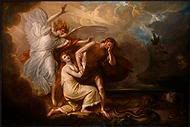

Every form of art is derived from a period and culture. The period of an artwork is the time in history it was created. The culture is the behavior and characteristic of a particular culture. The two paintings chosen have interesting and important periods and cultures.
The Dutch painter Quentin Massys created, “Ill-Matched Lovers” an oil on canvas in 1520/1525 during the 16th century. This was the period of Northern Renaissance. The Northern Renaissance style evolved gradually out of the late Middle Ages. As artists became increasingly entranced with myriad details of the visible world and better and better and capturing them (411). The strong detail is evident in the characters features and vibrant clothing in the painting. In a fundamental way, Northern painting are about looking (413) This entire painting is about looking. As earlier discussed Massys employed strong directional lines to draw the viewers eyes. The culture of this painting is Netherlandish, (Dutch). These artists didn’t live among the ruins of Rome, nor had the connection to the creators of Classical past.
American painter Benjamin West created “The expulsion of Adam and Eve from Paradise.” an oil on panel in 1791 during the 18th century. This period was deemed “The Age of Kings”. This is befitting for an American painter who eventually became the historical painter to the king during this periods. Although this magnificent piece is created by an American, It was painted in Europe during the Baroque Era. Baroque art is full of emotion, energy, and movement. Colors are more vivid in Baroque art than in renaissance, with greater contrast between colors and between light and dark (421). As discussed before, West employs value by painting the focal point in light hues and the surrounding in darker colors. This technique brings forth emotion and energy from the painting.
Both painting hail from unique and historical era’s in Art history. These periods and culture will forever be interesting and have an impact on Art.
No comments:
Post a Comment